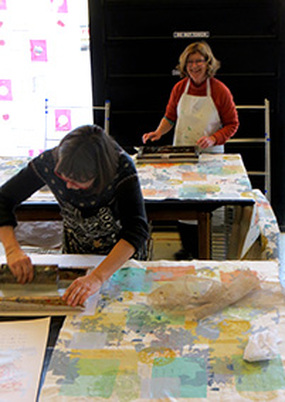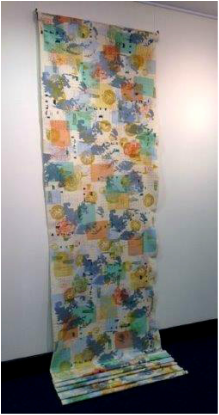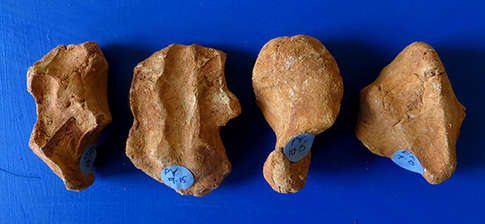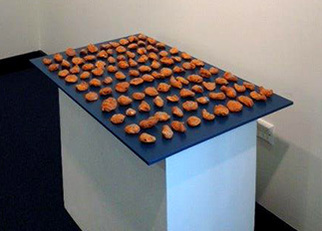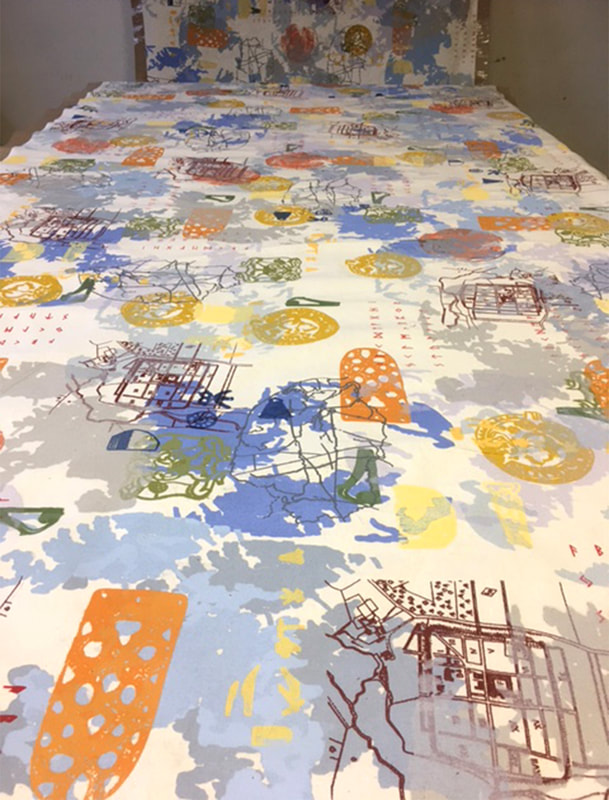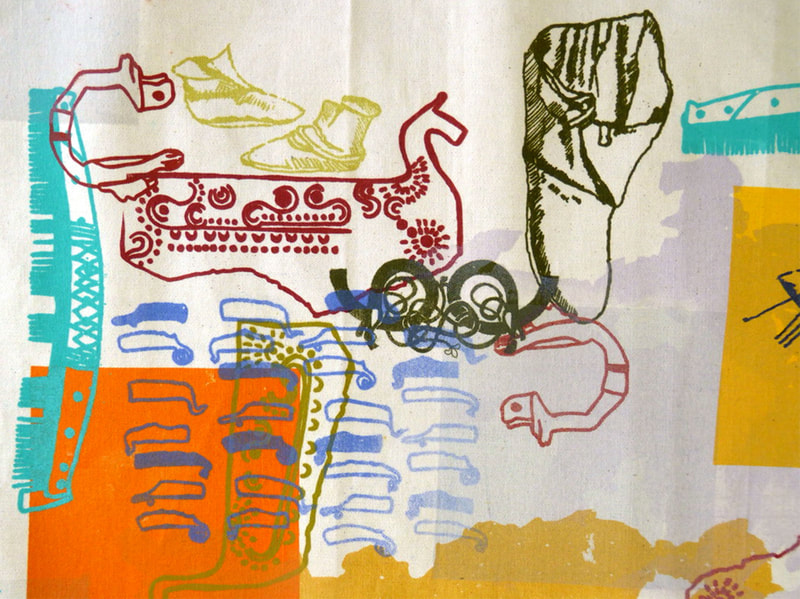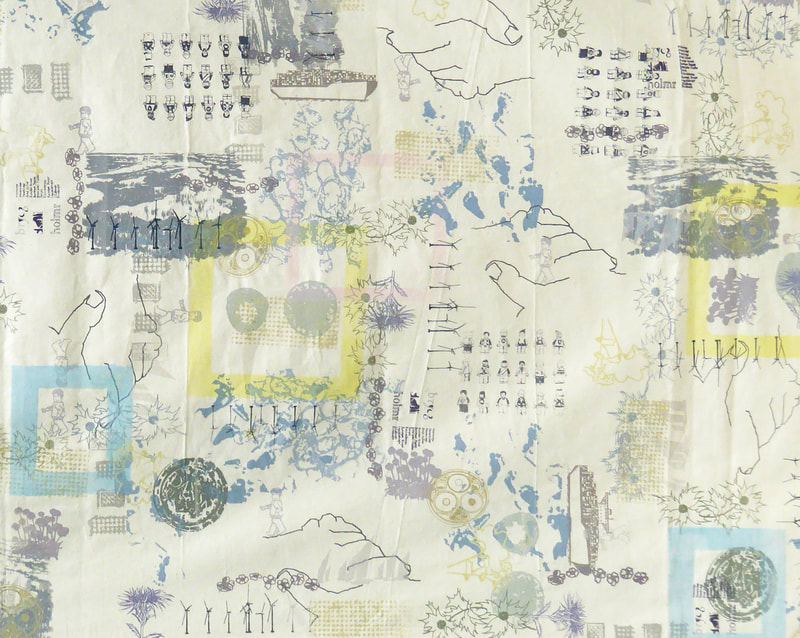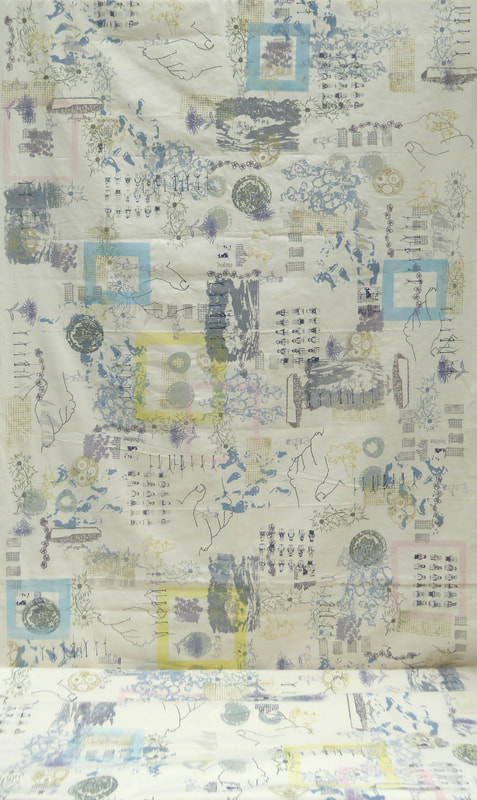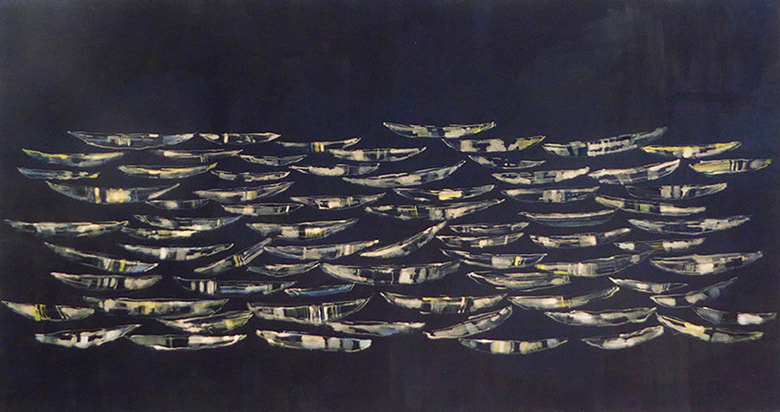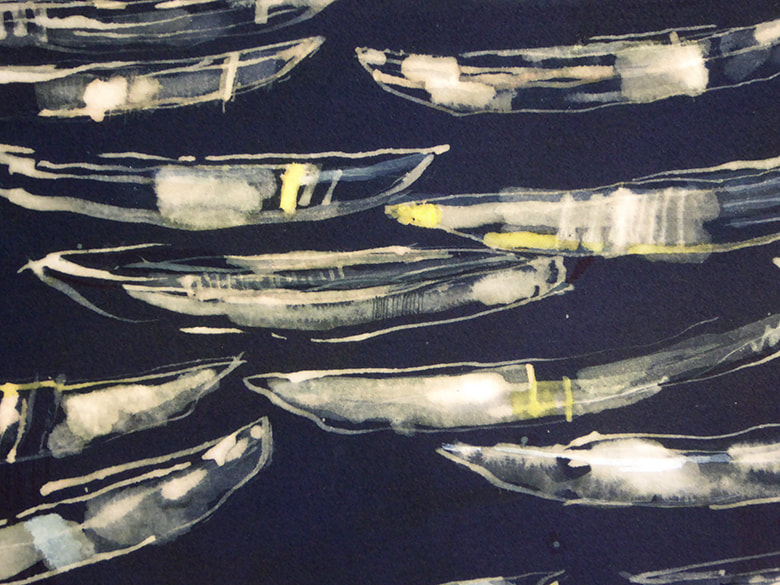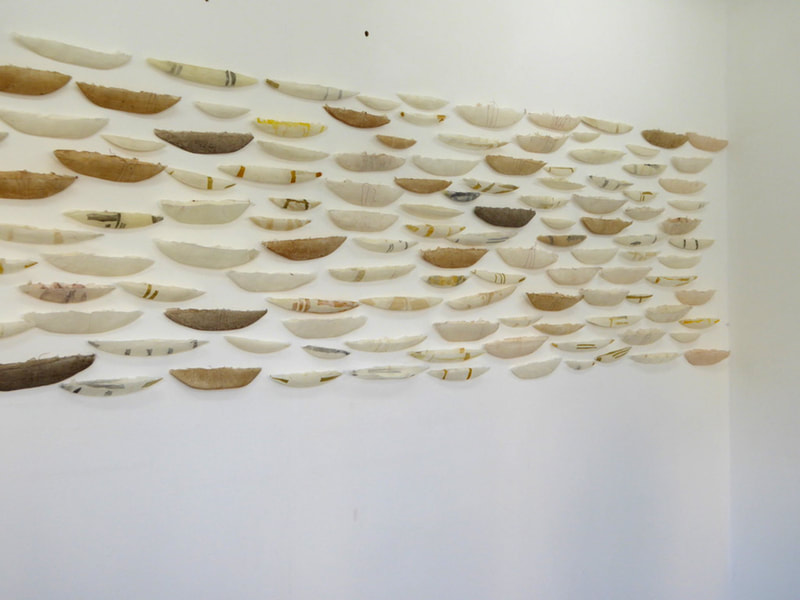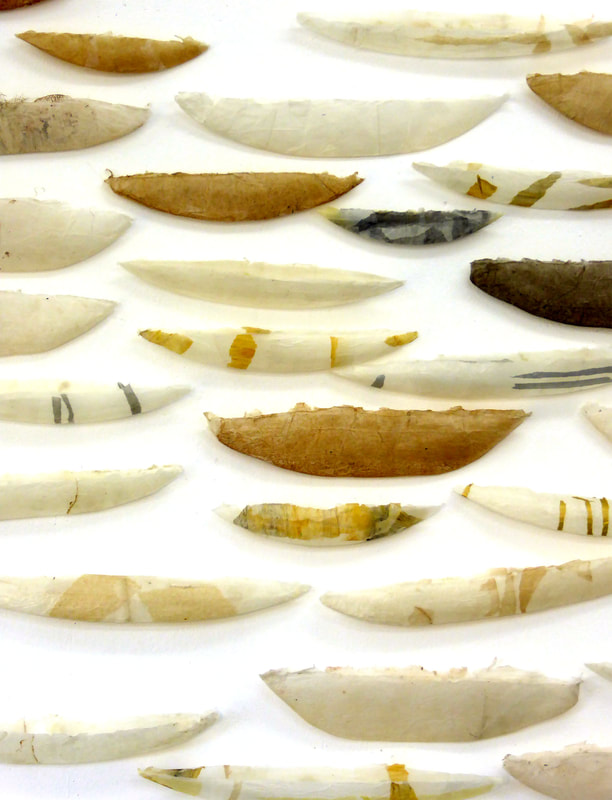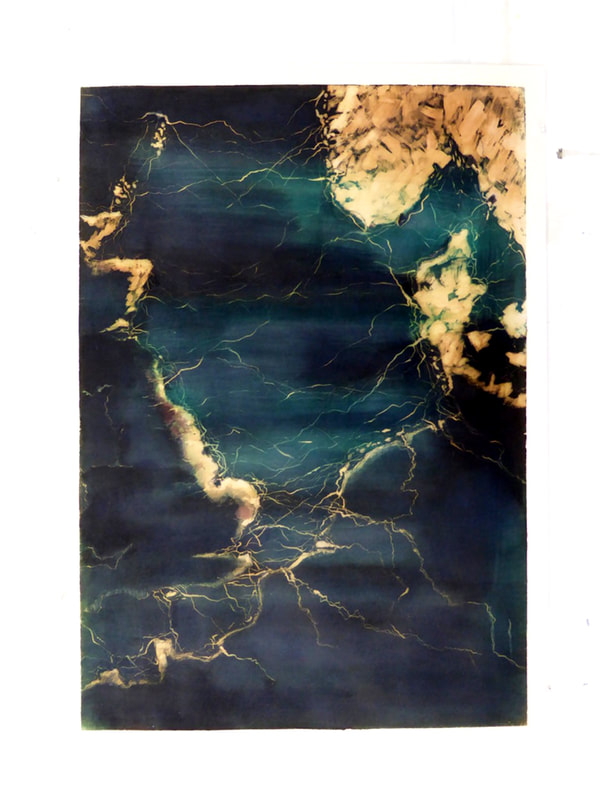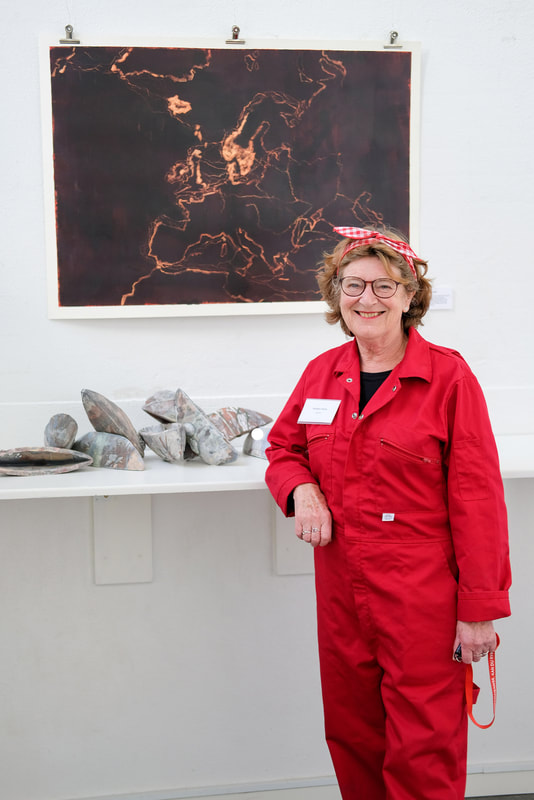|
Collaborative Projects
|
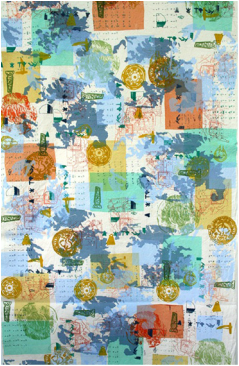
Norfolk 2000 Brenda Unwin and Sarah Caputo
In 2015 we were commissioned by the Arts Council funded 'Norfolk 2000' project (www.norfolk2000.co.uk) to work alongside professionals from Norfolk Museums Service and the UEA and respond to the idea of 2000 years of immigration into East Anglia. We studied artefacts from the museums collections (their manufacture, technology, origin, history, design and cultural purpose), attended a series of lectures and carried out independent research. The resulting work was exhibited regionally culminating at the Forum, Norwich, in June 2015 and was plauded for its conceptual accessibility.
Archaeology of Images
It must have happened when I went to the market at Venta Icenorum. I was looking for some special pottery expected from Brampton, as a gift for friends who had recently arrived from Rome. In all the noise and bustle the pin from my brooch must have come loose. I searched everywhere but it had disappeared.
This could be the story behind some of the objects that have been lost, hoarded, buried in layer upon layer of earth over the last 2000yrs. The layering of printed images references time and archaeology, fabric the 16th century textile migrants and the use of colour evokes East Anglia and the objects themselves.
(detail)
In 2015 we were commissioned by the Arts Council funded 'Norfolk 2000' project (www.norfolk2000.co.uk) to work alongside professionals from Norfolk Museums Service and the UEA and respond to the idea of 2000 years of immigration into East Anglia. We studied artefacts from the museums collections (their manufacture, technology, origin, history, design and cultural purpose), attended a series of lectures and carried out independent research. The resulting work was exhibited regionally culminating at the Forum, Norwich, in June 2015 and was plauded for its conceptual accessibility.
Archaeology of Images
It must have happened when I went to the market at Venta Icenorum. I was looking for some special pottery expected from Brampton, as a gift for friends who had recently arrived from Rome. In all the noise and bustle the pin from my brooch must have come loose. I searched everywhere but it had disappeared.
This could be the story behind some of the objects that have been lost, hoarded, buried in layer upon layer of earth over the last 2000yrs. The layering of printed images references time and archaeology, fabric the 16th century textile migrants and the use of colour evokes East Anglia and the objects themselves.
(detail)
Archaeology of Images, Screenprinted Textile, 500cm x 100cm
Norfolk 2000
One Hundred Handshakes
How to encapsulate the essence of 2000 years.of migration to East Anglia from the Romans to the present day? Invaders or travellers, skilled craftsmen or traders, or those fleeing religious persecution, each bringing ideas and culture that have enriched communities.
The handshake signifies the essence of greeting or parting, a guarantee or commitment when exchanging goods and services, respect and acceptance of strangers. Using Norfolk clay from Sarah’s garden we asked people to shake hands thus preserving a record of human contact that is the same now as it was 2000 yrs. ago.
Their presentation references museum displays.
One Hundred Handshakes
How to encapsulate the essence of 2000 years.of migration to East Anglia from the Romans to the present day? Invaders or travellers, skilled craftsmen or traders, or those fleeing religious persecution, each bringing ideas and culture that have enriched communities.
The handshake signifies the essence of greeting or parting, a guarantee or commitment when exchanging goods and services, respect and acceptance of strangers. Using Norfolk clay from Sarah’s garden we asked people to shake hands thus preserving a record of human contact that is the same now as it was 2000 yrs. ago.
Their presentation references museum displays.
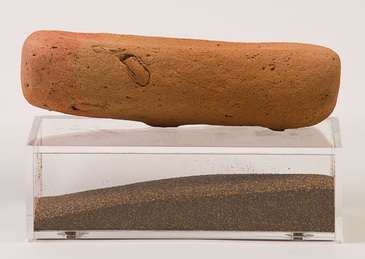
Cley 15 Marvellous in Ordinary
Time Sculpture, 2015, brick, sand, perspex
Brenda Unwin and Philip Walmsley
This work is about drawing attention to an everyday mundane object – the brick, which has been sculpted by time and natural forces.
We suspect its history is linked to the recent persistent coastal erosion, resulting in the demolition of domestic and military buildings. Its identity, marked by the number three, is curious.
We are interested in what is present and what is absent, the amount that is missing and has become part of the beach once more. The Perspex container is the size of a complete brick; the sand within it is equivalent to the amount of eroded brick.
The North Sea Lake 2021. Aarhus, Denmark
‘The North Sea is often perceived as a great divide, divorcing the British Isles from continental Europe. In cultural terms, however, it has always acted more as a lake, supporting communities around its fringes which have frequently had much in common. ...material culture was often more remarkable for its similarity across distance than for its diversity.’
'B. Ayers, Cities, Cogs and Commerce, Archaeological' approaches to the material culture of the North Sea World. Senior Research Fellow, University of East Anglia, UK
Since 2016 Sarah Caputo and I have been collaborating on the North Sea Lake project . We were awarded a research grant to travel to Denmark and organised meetings with Senior curators at the National museum in Copenhagen, Moesgaard Museum (Aarhus), Jelling and Viborg and Norwich and Kings Lynn museums in East Anglia and the British Museum. We investigated the cultural exchange of ideas and artefacts both historically and in contemporary times between East Anglia and Denmark. Working from drawings and photographs made on site we chose a selection of images that exemplified this interchange for three screenprinted textiles and explored the significance of boats and trading routes.
Details from Archaeology of Images 1 ,2 and 3.
See you tube links for more information
https://www.youtube.com/watch?v=6QxtZ9-3YjE&ab_channel=UngdomsWebTV
https://www.youtube.com/watch?v=53_LbyOKlKc&t=39s&ab_channel=UngdomsWebTV
https://www.youtube.com/watch?v=fUGQ7wj25TM&ab_channel=UngdomsWebTV
The North Sea Lake 2021. Aarhus, Denmark
‘The North Sea is often perceived as a great divide, divorcing the British Isles from continental Europe. In cultural terms, however, it has always acted more as a lake, supporting communities around its fringes which have frequently had much in common. ...material culture was often more remarkable for its similarity across distance than for its diversity.’
'B. Ayers, Cities, Cogs and Commerce, Archaeological' approaches to the material culture of the North Sea World. Senior Research Fellow, University of East Anglia, UK
Since 2016 Sarah Caputo and I have been collaborating on the North Sea Lake project . We were awarded a research grant to travel to Denmark and organised meetings with Senior curators at the National museum in Copenhagen, Moesgaard Museum (Aarhus), Jelling and Viborg and Norwich and Kings Lynn museums in East Anglia and the British Museum. We investigated the cultural exchange of ideas and artefacts both historically and in contemporary times between East Anglia and Denmark. Working from drawings and photographs made on site we chose a selection of images that exemplified this interchange for three screenprinted textiles and explored the significance of boats and trading routes.
Details from Archaeology of Images 1 ,2 and 3.
See you tube links for more information
https://www.youtube.com/watch?v=6QxtZ9-3YjE&ab_channel=UngdomsWebTV
https://www.youtube.com/watch?v=53_LbyOKlKc&t=39s&ab_channel=UngdomsWebTV
https://www.youtube.com/watch?v=fUGQ7wj25TM&ab_channel=UngdomsWebTV
Boats
The large mixed media drawing by Brenda Unwin and cast tissue paper boats (made by both of us) were inspired by a remarkable display of small fragile golden profiles of ships from a Viking chief’s burial in the National Museum in Copenhagen. We used tissue paper to suggest a ghost like quality of ships moving through water, barely seen or heard. Their fragility also evokes the uncertainty of sea voyages and the resilience of those who make, often-perilous journeys by sea both in historical and contemporary times to seek safety, to trade and for exploration.
The large mixed media drawing by Brenda Unwin and cast tissue paper boats (made by both of us) were inspired by a remarkable display of small fragile golden profiles of ships from a Viking chief’s burial in the National Museum in Copenhagen. We used tissue paper to suggest a ghost like quality of ships moving through water, barely seen or heard. Their fragility also evokes the uncertainty of sea voyages and the resilience of those who make, often-perilous journeys by sea both in historical and contemporary times to seek safety, to trade and for exploration.
Trading Routes
